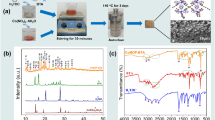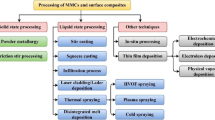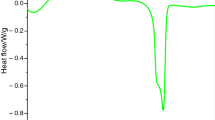Abstract
Waste materials are one of the biggest threats facing the environment today. In the present work, an attempt has been made by the utilization of waste materials into raw materials to reduce the material cost and so turn industrial wastes into industrial wealth. Experiments were performed in dry sliding conditions using a pin-on-disc apparatus against an EN31 steel counterface with an applied load of 10–50 N and sliding speed of 1–5 m/s with a sliding distance of 1200 m. The dominant mechanism in each regime was examined using a wear mechanism map. Severe wear, ultra-severe wear and mild wear regimes are observed by plotting a transition map through microstructural observations. The A356/10% (rice husk ash–fly ash) hybrid composite achieved higher wear resistance compared to an Al alloy. The mild wear regime is increased by the addition of waste particles. Worn surfaces and wear debris are identified using scanning electron microscope analysis, and the chemical composition of each element was evaluated by energy dispersive spectroscopy.

















Similar content being viewed by others
References
Bodunrin MO, Alaneme KK, Chown LH (2015) Aluminium matrix hybrid composites: a review of reinforcement philosophies; mechanical, corrosion and tribological characteristics. J Mater Res Technol 4(4):434–445
Zhang G, Wei Z, Chen B, Chen B (2017) Abnormal transient liquid phase bondability of high-volume fraction SiC particle-reinforced A356 composite for Cu interlayer and the interlayer improvement routes. J Mater Eng Perform 26(12):5921–5937
Lim SC, Ashby MF (1987) Overview no.55 wear-mechanism maps. Acta Metall 35(1):1–24
Abdullahi U, Maleque MA, Nirmal U (2013) Wear mechanisms map of CNT-Al nano-composite. Proc Eng 68:736–742
García-Rodríguez S, Torres B, Maroto A, López AJ, Otero E, Rams J (2017) Dry sliding wear behavior of globular AZ91 magnesium alloy and AZ91/SiCp composites. Wear 390:1
Rubino F, Pisaturo M, Senatore A, Carlone P, Sudarshan TS (2017) Tribological characterization of SiC and B4C manufactured by plasma pressure compaction. J Mater Eng Perform 26(11):5648–5659
Maros MB, Németh AK (2017) Wear maps of HIP sintered Si3N4/MLG nano composites for unlike paired tribosystems under ball-on-disc dry sliding conditions. J Euro Cer Soc 37(14):4357–4369
Ramanathan S (2010) Dry sliding wear behavior of as-cast ZE41A magnesium alloy. Mater Des 31(4):1930–1936
Omidi M, Khodabandeh A, Nategh S, Khakbiz M (2017) Wear mechanisms maps of CNT reinforced Al6061 nanocomposites treated by cryomilling and mechanical milling. Tribol Int 110:151–160
Rao RN, Das S, Mondal DP, Dixit G, Devi ST (2013) Dry sliding wear maps for AA7010 (Al–Zn–Mg–Cu) aluminium matrix composite. Tribol Int 60:77–82
Subrahmanyam AP, Narsaraju G, Rao BS (2015) Effect of rice husk ash and fly ash reinforcements on microstructure and mechanical properties of aluminium alloy (AlSi10Mg) matrix composites. Int J Adv Sci Technol 76:1–8
Vinod B, Ramanathan S (2018) Effect of Zener-Hollomon parameter on the flow behaviour and microstructure evolution of Al alloy with organic–inorganic hybrid composites. Int J Plast Technol 22(1):137–160
Vinod B, Ramanathan S, Anandajothi M (2018) Effect of organic and inorganic reinforcement on tribological behaviour of aluminium A356 matrix hybrid composite. J Bio Tribol Corr 4(3):45
Vinod B, Ramanathan S, Ananthi V, Selvakumar N (2018) Fabrication and characterization of organic and in-organic reinforced A356 aluminium matrix hybrid composite by improved double-stir casting. Silicon. https://doi.org/10.1007/s12633-018-9881-5
Bui DD, Hu J, Stroeven P (2005) Particle size effect on the strength of rice husk ash blended gap-graded Portland cement concrete. Cem Concr Compos 27(3):357–366
Surappa MK (2008) Dry sliding wear of fly ash particle reinforced A356 Al composites. Wear 265(3–4): 349–360
Wilson S, Alpas AT (1997) Wear mechanism maps for metal matrix composites. Wear 212(1):41–49
Aiguo W, Rack HJ (1991) Abrasive wear of silicon carbide particulate-and whisker-reinforced 7091 aluminum matrix composites. Wear 146(2):337–348
Hashish M (1989) A model for abrasive-waterjet (AWJ) machining. J Mater Eng Perform 111(2):154–162
Lim SC (1998) Recent developments in wear-mechanism maps. Tribol Int 31(1–3):87–97
Ilanaganar E, Anbuselvan S (2018) Wear mechanisms of AZ31B magnesium alloy during dry sliding condition. Mater Today 5(1):628–635
Yusof NF, Ripin ZM (2016) A technique to measure surface asperities plastic deformation and wear in rolling contact. Wear 368:496–504
Linsler D, Schröckert F, Scherge M (2016) Influence of subsurface plastic deformation on the running-in behavior of a hypoeutectic AlSi alloy. Tribol Int 100:224–230
Antoniou R, Subramanian C (1988) Wear mechanism map for aluminium alloys. Scr Met 22(6):809–814
Liang C, Han X, Su TF, Li C, An J (2014) Sliding wear map for AZ31 magnesium alloy. Tribol Trans 57(6):1077–1085
Altaie A, Bubb NL, Franklin P, Dowling AH, Fleming GJ, Wood DJ (2017) An approach to understanding tribological behaviour of dental composites through volumetric wear loss and wear mechanism determination; beyond material ranking. J Dent 59:41–47
Ashby MF, Lim SC (1990) Wear-mechanism maps. Scr Metall Mater 24(5):805–810
Lim SC (2002) The relevance of wear-mechanism maps to mild-oxidational wear. Tribol Int 35(11):717–723
Azhaarudeen S, Faruck AA, Nevosad A (2018) Tribological behaviour and wear mechanisms of manganese phosphate coatings under dry reciprocating sliding contact conditions. Tribol Int 122:189–199
Selvakumar N, Ramkumar T (2016) Effects of high temperature wear behaviour of sintered Ti–6Al–4V reinforced with nano B4C particle. Trans Indian Inst Metals 69(6):1267–1276
Vanarotti M, Shrishail P, Sridhar BR, Venkateswarlu K, Kori SA (2014) Study of mechanical properties & residual stresses on post wear samples of A356-SiC metal matrix composites. Proc Mater Sci 5:873–882
Acknowledgements
The authors would like to thank the Director of ‘Nano centre’, Mepco Engineering College, for support in the fabrication of the samples. The authors are also grateful for the extended laboratory facilities at the Department of manufacturing, Annamalai University, India.
Author information
Authors and Affiliations
Corresponding author
Ethics declarations
Conflict of interest
The authors declare that they have no conflict of interest.
Additional information
Publisher’s Note
Springer Nature remains neutral with regard to jurisdictional claims in published maps and institutional affiliations.
Rights and permissions
About this article
Cite this article
Ramanathan, S., Vinod, B., Narayanasamy, P. et al. Dry Sliding Wear Mechanism Maps of Al–7Si–0.3Mg Hybrid Composite: Novel Approach of Agro-Industrial Waste Particles to Reduce Cost of Material. J Bio Tribo Corros 5, 32 (2019). https://doi.org/10.1007/s40735-019-0227-7
Received:
Revised:
Accepted:
Published:
DOI: https://doi.org/10.1007/s40735-019-0227-7




